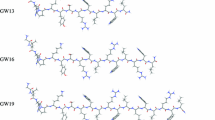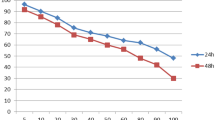Abstract
Gastric cancer is one of the most common malignant cancers worldwide. Due to its poor prognosis and high mortality rate, development of an effective therapeutic method is of urgent need. It has been reported that antimicrobial peptides (AMPs), also known as host-defense peptides, can selectively bind to negatively charged prokaryotic and cancer cell membranes and exert cytotoxicity, without harming normal cells or causing severe drug resistance. We have designed a series of novel cationic AMPs with potent antimicrobial activity against a broad spectrum of bacterial pathogens. In the current study, we evaluated their anticancer potency toward gastric cancer AGS cell line. Cell viability assay revealed that GW-H1 exhibited the lowest IC50 value (less than 20 μM). Flow cytometry showed that upon GW-H1 treatment for 0–24 h, apoptotic cell populations of AGS increased in a dose- and time-dependent manner. Western blot analysis further revealed that upon treatment for 2–6 h, apoptosis-related caspases-3, 7, 8, 9, and PARP were cleaved and activated, while autophagy-related LC3-II and beclin-1 were concomitantly increased. These results indicated that both apoptosis and autophagy were involved in the early stage of GW-H1-induced AGS cell death. However, upon treatment for 12–24 h, LC3-II began to decrease and cleaved beclin-1 increased in a time-dependent manner, suggesting that consecutive activation of caspases cleaved beclin-1 to inhibit autophagy, thus enhancing apoptosis at the final stage. These findings provided support for future application of GW-H1 as a potential anticancer agent for gastric cancer treatment.







Similar content being viewed by others
References
Kelley JR, Duggan JM (2003) Gastric cancer epidemiology and risk factors. J Clin Epidemiol 56:1–9
Guggenheim DE, Shah MA (2013) Gastric cancer epidemiology and risk factors. J Surg Oncol 107:230–236
Baeza MR, Giannini TO, Rivera SR, Gonzalez P, Gonzalez J, Vergara E, del Castillo C, Madrid J, Vines E (2001) Adjuvant radiochemotherapy in the treatment of completely resected, locally advanced gastric cancer. Int J Radiat Oncol Biol Phys 50:645–650
Longley DB, Harkin DP, Johnston PG (2003) 5-Fluorouracil: mechanisms of action and clinical strategies. Nat Rev Cancer 3:330–338
Cascinu S, Scartozzi M, Labianca R, Catalano V, Silva RR, Barni S, Zaniboni A, D’Angelo A, Salvagni S, Martignoni G (2004) High curative resection rate with weekly cisplatin, 5-fluorouracil, epidoxorubicin, 6S-leucovorin, glutathione, and filgrastim in patients with locally advanced, unresectable gastric cancer: a report from the Italian Group for the Study of Digestive Tract Cancer (GISCAD). Br J Cancer 90:1521–1525
Baker MA, Maloy WL, Zasloff M, Jacob LS (1993) Anticancer efficacy of Magainin 2 and analogue peptides. Cancer Res 53:3052–3057
Chen HM, Wang W, Smith D, Chan SC (1997) Effects of the anti-bacterial peptide cecropin B and its analogs, cecropins B-1 and B-2, on liposomes, bacteria, and cancer cells. Biochim Biophys Acta 1336:171–179
Cruciani RA, Barker JL, Zasloff M, Chen HC, Colamonici O (1991) Antibiotic magainins exert cytolytic activity against transformed cell lines through channel formation. Proc Natl Acad Sci USA 88:3792–3796
Eliassen LT, Berge G, Sveinbjornsson B, Svendsen JS, Vorland LH, Rekdal O (2002) Evidence for a direct antitumor mechanism of action of bovine lactoferricin. Anticancer Res 22:2703–2710
Johnstone SA, Gelmon K, Mayer LD, Hancock RE, Bally MB (2000) In vitro characterization of the anticancer activity of membrane-active cationic peptides. I. Peptide-mediated cytotoxicity and peptide-enhanced cytotoxic activity of doxorubicin against wild-type and p-glycoprotein over-expressing tumor cell lines. Anticancer Drug Des 15:151–154
Ohsaki Y, Gazdar AF, Chen HC, Johnson BE (1992) Antitumor activity of magainin analogues against human lung cancer cell lines. Cancer Res 52:3534–3538
Utsugi T, Schroit AJ, Connor J, Bucana CD, Fidler IJ (1991) Elevated expression of phosphatidylserine in the outer membrane leaflet of human tumor cells and recognition by activated human blood monocytes. Cancer Res 51:3062–3066
Yang N, Stensen W, Svendesen JS, Rekdal O (2002) Enhanced antitumor activity and selectivity of lactoferrin-derived peptides. J Pept Res 60:187–197
Yang N, Lejon T, Rekdal O (2003) Antitumor activity and specificity as a function of substitutions in the lipophilic sector of helical lactoferrin-derived peptides. J Pept Sci 9:300–311
Chang WT, Pan CY, Rajanbabu V, Cheng CW, Chen JY (2011) Tilapia (Oreochromis mossambicus) antimicrobial peptide, hepcidin 1-5, shows antitumor activity in cancer cells. Peptides 32:342–352
Chen JY, Lin WJ, Lin TL (2009) A fish antimicrobial peptide, tilapia hepcidin TH2-3, shows potent antitumor activity against human fibrosarcoma cells. Peptides 30:1636–1642
Epand RM, Vogel HJ (1999) Diversity of antimicrobial peptides and their mechanisms of action. Biochim Biophys Acta 1462:11–28
Guo K, Kang NX, Li Y, Sun L, Gan L, Cui FJ (2009) Regulation of HSP27 on NF-kappaB pathway activation may be involved in metastatic hepatocellular carcinoma cells apoptosis. BMC Cancer 9:100
Hsu JC, Lin LC, Tzen JT, Chen JY (2011) Characteristics of the antitumor activities in tumor cells and modulation of the inflammatory response in RAW264.7 cells of a novel antimicrobial peptide, chrysophsin-1, from the red sea bream (Chrysophrys major). Peptides 32:900–910
Huang HN, Rajanbabu V, Pan CY, Chan YL, Wu CJ, Chen JY (2013) A cancer vaccine based on the marine antimicrobial peptide pardaxin (GE33) for control of bladder-associated tumors. Biomaterials 34:10151–10159
Lin WJ, Chien YL, Pan CY, Lin TL, Chen JY, Chiu SJ, Hui CF (2009) Epinecidin-1, an antimicrobial peptide from fish (Epinephelus coioides) which has an antitumor effect like lytic peptides in human fibrosarcoma cells. Peptides 30:283–290
Lin MC, Lin SB, Chen JC, Hui CF, Chen JY (2010) Shrimp anti-lipopolysaccharide factor peptide enhances the antitumor activity of cisplatin in vitro and inhibits HeLa cells growth in nude mice. Peptides 31:1019–1025
Lin MC, Lin SB, Lee SC, Lin CC, Hui CF, Chen JY (2010) Antimicrobial peptide of an anti-lipopolysaccharide factor modulates of the inflammatory response in RAW264.7 cells. Peptides 31:1262–1272
Papo N, Shahar M, Eisenbach L, Shai Y (2003) A novel lytic peptide composed of DL-amino acids selectively kills cancer cells in culture and in mice. J Biol Chem 278:21018–21023
Andreu D, Rivas L (1998) Animal antimicrobial peptides: an overview. Biopolymers 47:415–433
Chou HT, Wen HW, Kuo TY, Lin CC, Chen WJ (2010) Interaction of cationic antimicrobial peptides with phospholipid vesicles and their antibacterial activity. Peptides 31:1811–1820
Matsuzaki K, Sugishita K, Ishibe N, Ueha M, Nakata S, Miyajima K, Epand RM (1998) Relationship of membrane curvature to the formation of pores by magainin 2. Biochemistry 37:11856–11863
Sitaram N, Nagaraj R (1999) Interaction of antimicrobial peptides with biological and model membranes: structural and charge requirements for activity. Biochim Biophys Acta 1462:29–54
Ellerby HM, Arap W, Ellerby LM, Kain R, Andrusiak R, Rio GD, Krajewski S, Lombardo CR, Rao R, Ruoslahti E, Bredesen DE, Pasqualini R (1999) Anti-cancer activity of targeted pro-apoptotic peptides. Nat Med 5:1032–1038
Mai JC, Mi Z, Kim SH, Ng B, Robbins PD (2001) A proapoptotic peptide for the treatment of solid tumors. Cancer Res 61:7709–7712
Chou HT, Kuo TY, Chiang JC, Pei MJ, Yang WT, Yu HC, Lin SB, Chen WJ (2008) Design and synthesis of cationic antimicrobial peptides with improved activity and selectivity against Vibrio spp. Int J Antimicrob Agents 32:130–138
Chen YL, Li JH, Yu CY, Lin CJ, Chiu PH, Chen PW, Lin CC, Chen WJ (2012) Novel cationic antimicrobial peptide GW-H1 induced caspase-dependent apoptosis of hepatocellular carcinoma cell lines. Peptides 36:257–265
Pan WR, Chen PW, Chen YL, Hsu HC, Lin CC, Chen WJ (2013) Bovine lactoferricin B induces apoptosis of human gastric cancer cell line AGS by inhibition of autophagy at a late stage. J Dairy Sci 96:7511–7520
Dennison SR, Whittaker M, Harris F, Phoenix DA (2006) Anticancer alpha-helical peptides and structure/function relationships underpinning their interactions with tumour cell membranes. Curr Protein Pept Sci 7:487–499
Riedl S, Zweytick D, Lohner K (2011) Membrane-active host defense peptides-challenges and perspectives for the development of novel anticancer drugs. Chem Phys Lipids 164:766–781
Barth S, Glick D, Macleod KF (2010) Autophagy: assays and artifacts. J Pathol 221:117–124
Denton D, Nicolson S, Kumar S (2012) Cell death by autophagy: facts and apparent artefacts. Cell Death Differ 19:87–95
Nikoletopoulou V, Markaki M, Palikaras K, Tavernarakis N (2013) Crosstalk between apoptosis, necrosis and autophagy. Biochim Biophys Acta 1833:3448–3459
Fimia GM, Piacentini M (2010) Regulation of autophagy in mammals and its interplay with apoptosis. Cell Mol Life Sci 67:1581–1588
Li H, Wang P, Sun Q, Ding WX, Yin XM, Sobol RW, Stolz DB, Yu J, Zhang L (2011) Following cytochrome C release, autophagy is inhibited during chemotherapy-induced apoptosis by caspase 8-mediated cleavage of Beclin 1. Cancer Res 71:3625–3634
Kang R, Zeh HJ, Lotze MT, Tang D (2011) The Beclin 1 network regulates autophagy and apoptosis. Cell Death Differ 18:571–580
Giansanti V, Torriglia A, Scovassi AI (2011) Conversation between apoptosis and autophagy: “Is it your turn or mine?”. Apoptosis 16:321–333
Shimizu S, Kanaseki T, Mizushima N, Mizuta T, Arakawa-Kobayashi S, Thompson CB, Tsujimoto Y (2004) Role of Bcl-2 family proteins in a non-apoptotic programmed cell death dependent on autophagy genes. Nat Cell Biol 6:1221–1228
Shimizu S, Konishi A, Nishida Y, Mizuta T, Nishina H, Yamamoto A, Tsujimoto Y (2010) Involvement of JNK in the regulation of autophagic cell death. Oncogene 29:2070–2082
Zhou F, Yang Y, Xing D (2011) Bcl-2 and Bcl-Xl play important roles in the crosstalk between autophagy and apoptosis. FEBS J 278:403–413
Yu L, Alva A, Su H, Dutt P, Freundt E, Welsh S, Baehrecke EH, Lenardo MJ (2004) Regulation of an ATG7-beclin 1 program of autophagic cell death by caspase-8. Science 304:1500–1502
Acknowledgments
Grant sponsor: National Science Council of Taiwan. Grant numbers: NSC 100-2311-B-197-001 and NSC 101-2311-B-197-001.
Conflict of interest
No competing financial interests exist.
Author information
Authors and Affiliations
Corresponding author
Electronic supplementary material
Below is the link to the electronic supplementary material.
Rights and permissions
About this article
Cite this article
Pan, WR., Chen, YL.S., Hsu, HC. et al. Antimicrobial peptide GW-H1-induced apoptosis of human gastric cancer AGS cell line is enhanced by suppression of autophagy. Mol Cell Biochem 400, 77–86 (2015). https://doi.org/10.1007/s11010-014-2264-3
Received:
Accepted:
Published:
Issue Date:
DOI: https://doi.org/10.1007/s11010-014-2264-3




